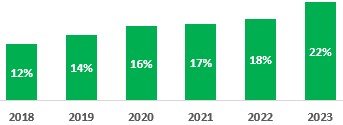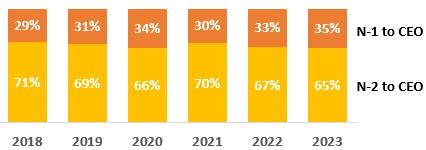For many companies, changing course is often urgent. However, transforming a company is never easy. According to BCG, “up to seven in ten company transformations fall short of their goals”.
It is a long journey that involves reinventing the business, changing mindsets, and pivoting the organization. According to McKinsey, “the chief transformation officer will significantly increase the chances of a successful transformation”.
What do chief transformation officers do?
Here is how three chief transformation officers describe their missions on their LinkedIn profiles:
- “I work with the Group Executive Committee and other senior executives across the bank to accelerate the delivery of strategy through transformation, driving clear outcomes, profitability, and great customer experiences” a group chief transformation officer in banking.
- “Always been passionate about innovation. My goal is to enrich the value proposition with digital and technology, for a greater customer experience and a timely response to their needs” a group chief transformation in insurance.
- “Digitizing and integrating products and processes to bring truly integrated logistics to customers. Global M&A integration” a senior vice president, chief transformation officer in maritime.
Chief transformation officers (or VPs transformation) are high-level conductors of complex processes involving hundreds of initiatives across many fields. Igniting passion and enthusiasm, they act as an extension of the CEO to engage the top managers across the functions to make the transformation deliver.
Beyond being a good problem solver, their tasks require a high emotional quotient and strong interpersonal skills to sail on the treacherous waters of transformation.
22% of the Global Fortune 500 have now at least one VP transformation
To gain a better understanding, for the past six years we have observed the organizational charts of the 500 most successful companies – namely the Global Fortune 500 as listed by Fortune.com in June 2022.
Share of Global Fortune 500 companies with VPs Transformation
The share of Global Fortune 500 companies with one or more VPs transformation in their executive team, has grown by an amazing 83% from 12% in 2018 to 22% in 2023.
The executive team is defined as reporting to the CEO (N-1 to the CEO) or reporting to an executive reporting to the CEO (N-2 to the CEO).
What do they prioritize?
At each of the Global Fortune 500 companies, we are looking left at the focus of their most senior transformation roles as of January 1, 2023:
Fifty-five percent of the roles are full-time and dedicated to a strategic or flickering segment (dark green). Their transformation focuses are most often dedicated to digital, business or finance, as shown in their business titles e.g.,
- Vice President of Digital Transformation,
- Executive Vice President, Corporate Business Transformation, or
- Vice President, Risk and Finance Transformation.
Twelve percent of the roles are also full-time but are dedicated to their global company transformation roles (light green) e.g.,
- Chief Transformation Officer,
- Group Head of Transformation, or
- Senior Vice President, Enterprise Transformation.
The remaining thirty-three percent of the roles have a global enterprise transformation assignment cumulated with another role such as digital, human resources or business (yellow), e.g.,
- Chief Digital and Transformation Officer,
- Chief Transformation Officer and Chief People Officer, or
- Executive Vice President, Global Business Services and Transformation.
How much experience do they have on the job?
Leading the transformation of a large company is a major undertaking. It takes time to define, convince, and execute.
Multiple capabilities are required for the individual leading the transformation. According to BCG, traits such as “persistence, hypervigilance, flexibility” and being a “role model for change” are strong success factors.
Transformation role tenures at the Global Fortune 500 companies
Above is the breakdown showing that 35% have less than one year’s tenure on the job as of January 1, 2023. Overall, the executives have been in their transformation role for about two years on average.
What were their former experiences?
For 43% of the executives, the transformation mission is their second or third job within the company’s executive team. They have been part of the executive team for four and a half years, including one and half years in their transformation mission.
The remaining 57% joined the executive team with a transformation mission (as an outsider coming from another company or a company’s insider being promoted). They have held their transformation roles on the executive team for two years on average.
Do they report to their CEOs?
Yes, in 35% of the Global Fortune 500 companies, their most senior VP transformation now reports directly to the CEO (N-1 to the CEO).
Reporting levels of VPs Transformation at the Global Fortune 500 companies
Growth has been steady year over year from 29% to 35%, acknowledging for the growing importance of transformation in the CEOs’ priorities.
In which industries do they operate?
The Global Fortune 500 companies in healthcare, finance, and consumer have invested the most in their transformations, with over 33% of their companies having a head of transformation in their executive team in 2023.

Share of Global Fortune 500 companies with VPs transformation by industry
This impressive surge has not happened overnight. In each of these three industries, companies have steadily invested in these transformation roles since 2018.
Where are they located?
Fortune 500 Companies in North America (NA) and in Europe, the Middle East, and Africa (EMEA) have invested at about the same pace to transform themselves, with a stunning 31% of them now having at least one VP transformation in their executive team.
Share of Global Fortune 500 with VPs transformation by region
Companies in Asia and the Pacific (APAC) have not yet opted for that type of organization to run their transformation.
Pilotage toward the future
The McKinsey Global Survey highlights that “business leaders expect that by 2026, half of their companies’ revenues will come from products, services, or businesses that haven’t been created yet”.
Chief transformation officers’ job is to imagine and energize the future. Transforming has more and more often become a permanent state of thinking to reinvent the company’s future. But delivering never-ending changes can lead to fatigue and resignation in any organization.
Chief transformation officers’ required traits and experiences look like a Swiss knife. To help out large companies in their transformations, the largest consulting firms including, BCG, Gartner, Mercer and McKinsey have all developed advanced transformation practices.
The VP transformation surge also is also happening beyond the 500 largest companies: As of January 1, 2023, 2,584 companies out of the 80,453 medium or large companies that The Official Board follows had at least one VP transformation. On January 1, 2016 (seven years ago), they were in just 43 companies.
Methodology: The company sample is the Global Fortune 500 companies published on Fortune.com as of June 2022. From each company’s organizational chart as of January 1st between 2018 and 2023 on The Official Board, have been extracted the business titles including the word “transformation”. To learn more, please contact us at [email protected].




